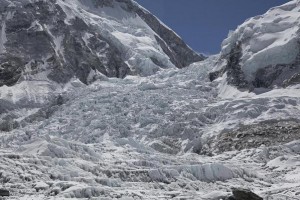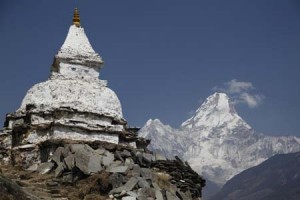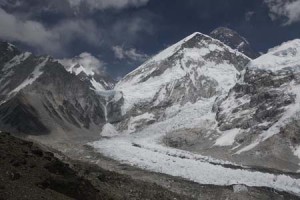Yesterday we headed up from BC to Camp 1, which takes us through the famed Khumbu Ice Fall. It was the scariest thing I have ever done in my life. And I’m gonna do it another 3 times or so. I can’t wait. But let me start at the beginning.
There is much hype about the Khumbu Ice Fall. Anyone going to Everest must choose whether or not they want to cross it; for those choosing not to there’s the North (Chinese) route. If you read my blog entry North vs. South I discuss the ice fall as a major decision maker, among other things.
The way I had justified being okay with crossing the ice fall was that it is just a lottery system. If you are in the wrong place at the wrong time and a serac falls on you, maybe it was just your time to go. It can be just as likely as being in a car accident, or changing the light bulb and falling off a chair/ladder.
When we arrived to base camp and saw the ice fall, it didn’t seem to be able to live up to this hype. It looked like a nice peaceful ice field, just another obstacle we would have to cross. What naïve thinking…
When morning rolls around on April 16, we get ready to make our first trip through the ice fall. We woke up after 3:00 am with the intention of being in the ice fall during the coldest part of the day, when the chances or seracs falling are the lowest. We leave at 4:00 am with our headlamps on and start walking. Once we get to the steep section of the fall, the danger becomes obvious. Most of the time we are walking under, around, or on top of huge seracs (that seem to be anchored pretty well, but you never know).
My style of walking is usually slow and steady, with a keen eye on my heart rate, to make sure I don’t waste too much energy on the acclimatization hikes; I want to save as much as possible for the summit push. When navigating the ice fall, the Sherpas we were walking with would often say, “Please, walk faster through here, not a safe section. We slow down later.†I obviously take their advice, walk faster and watch my heart rate soar partly from the exertion, partly from the fear of the place. I get thirsty but I don’t want to stop for a drink. I have to go pee but keep pushing on until we get to a “safe†section which would be hours away.
On the way up nothing dramatic happened. No seracs fell, no one fell off any ladders while crossing them. So I could have taken this imposed fear as nothing but a joke, but I have learned to take advice from people more experienced than me. So I knew it was real.
I was also beat. The ice fall is a technically and physically tough place to be. Not being able to pace oneself or stop for breaks doesn’t help. Once I made it to the top of the fall, there were other members of my group sitting having lunch. Camp 1 was another 1 hour away, on relatively flat ground. It was already 10:00 am; I had spent 6 hours getting myself up the ice fall. I did not really want to go on, as we still had to go back down through the ice fall to base camp. If I started back at noon I would be among the seracs when they are most likely to be falling. Luckily, I was able to give my supplies that I had been carrying to stash at camp 1 to one of the Sherpas, who “ran†up to camp 1, stashed it there, and still managed to pass me on the way down.

Khumbu Ice Fall
The way down. This is where the action took place. By the time we started down at 10:30 or so, the sun was well up. Reflecting off the sides of Lhola and Nuptse (the mountains on each side of the ice fall) as well as the millions of tons of white ice in the ice fall itself, the sun creates an oven effect. Going up I wore 4 layers, fleece gloves, warm hat. Going down I was down to a single shirt, hat to protect from the sun, and liner gloves more to protect from burning by the sun or rope than for warmth. All that heat we felt was felt by the ice fall itself as well, and I could see water starting to drip in places.
Going down was thankfully a bit easier. We would clip ourselves to a fixed rope for safety, then hold on to the rope as we navigated sections of varying steepness. The bad thing was I was tired, dehydrated, and going was slow. But again we had the insistence of the Sherpas we were with, “Please, no rest, we continue until safe place.†So we continued.
Then all of a sudden there is a loud crash above us, and everyone turns around to look. A serac has broken off less than 100m above us, toppled down, and is breaking up into bits as it comes down. I hear the Sherpa behind me start chanting something over and over again, I assume it’s some sort of prayer; instinctively I also cross myself. As we watch the ice lose steam and the dust settle, we have a closer look around, and realize the serac broke off to the left of the route, so posed no danger to anyone. Whew. But okay, this stuff is real, let’s get ourselves out of here.
We continue down, and after I don’t know how many minutes, we hear another crash on our right. Once again we all look, I hear the chant behind me again, I cross myself, as we all watch another serac, this one at our level and maybe 20 meters away, come crashing down and smash itself to bits. This one was close. All of a sudden the Sherpas behind me (not from our group) politely push their way past and start going down faster. I, already tired, dehydrated, hungry, hot and sweating, take their lead, kick it into gear, and pick up my pace. No longer am I wasting time to clip into and out of the safety rope. What is the point of protecting oneself from a fall of a few meters when there’s the threat of getting crushed by a giant serac? I just hold on to the rope with my hand, jump over little crevasses, cross ladders in double time.
What’s going through my head? I hate this place. The Khumbu Ice Fall is one mean SOB. It has already physically kicked my ass, punched me in the nuts, chewed me up, and I’m just waiting for it to spit me out, hopefully still alive. (Actually, my thought had a lot more swear words in them, but you get my drift.) I wondered why I was stupid enough to not go on the North side. This justification of the ice fall being a lottery was somehow not enough anymore. Once I thought of the mechanism of how I would actually die by serac, I didn’t want to die this way. Would the ice knock me in the head and kill me quick? Or would the big blocks just pin me, break some bones and paralyze me while I died slowly from the cold? Or would the sharp ice also cut me up, make me bleed as I was shoved into some crevasse, bleeding to death very slowly because the cold ice would preserve me for longer than normal? Whatever way it would be I couldn’t think about it for very long, but I knew I had to get out of there.
I hate to be overly dramatic with what I’m saying above. But that is how it happened. And that is how I felt, never more scared in my life.
Anyways, to make a long story even longer, we all got down with no further incidents. Others were in the ice fall longer, for more of the day, and we heard no news of any deaths. So things weren’t that bad. I got back to base camp the most tired I have been yet on this trip.
So now, looking ahead. Yes, we will cross the ice fall again. But we will never again go up and down in the same day. So we should be able to make the most of the cold night and navigate the ice fall only during this time. And as we get more and more acclimatized we will move through it faster, lowering our exposure time to the danger. It didn’t kill me the first time, and knowing what to expect, I will be less afraid of it each subsequent time. What doesn’t kill you only makes you stronger, right?
Another point I wanted to make. On Cho Oyu, the elevation gain from Base Camp to Camp 1 was about 1100m. It was hard at first, but it became no big deal. The elevation gain on Everest from BC to Camp 1 is less than 600m. But it feels a lot more difficult, takes a lot more out of you, requires more rest days to recover from it. This was confirmed by others who had been on Cho: Everest already seems 10 times more difficult than Cho Oyu ever was. We have to spend a lot of time and effort on simply surviving here: on hydrating well, eating well, staying healthy, staying warm, staying sane (everyone has thoughts of going home, dealing with those thoughts is part of staying sane). On Cho Oyu I was taking my 2kg camera with me on almost all acclimatization hikes, taking photos, videos, thinking about composition, making cool effects with depth of field, time lapse photos. Here I have not used my camera in days. Unless I feel really strong on summit push (or I can pawn it off on a Sherpa) I might not take me camera any higher than BC, where it sits now. Photography has taken a back seat. Since I am doing this climb for charity I had in mind ideas for photos and videos, to promote the charity and some of the bigger supporters at various stages of the climb. That has now moved way down on my list, the priority is to be prepared to attempt the summit.
Okay, that’s about all I had on my mind. A bit of a long read but I don’t think I’ll have much more to say anytime soon. Just FYI, I do not have access to my email, so I cannot respond to or even read anything you send me, this blog is being sent via one-way stream, I won’t bore you with details.
Hope everyone is doing well back home, my family in Calgary, Singapore, Poland (among other places), my friends in Calgary and all over the place, any ex-coworkers that may be following, and anybody else that may have found an interest in what I’m doing and how I’m writing about it. Take care and see you when I get back!





